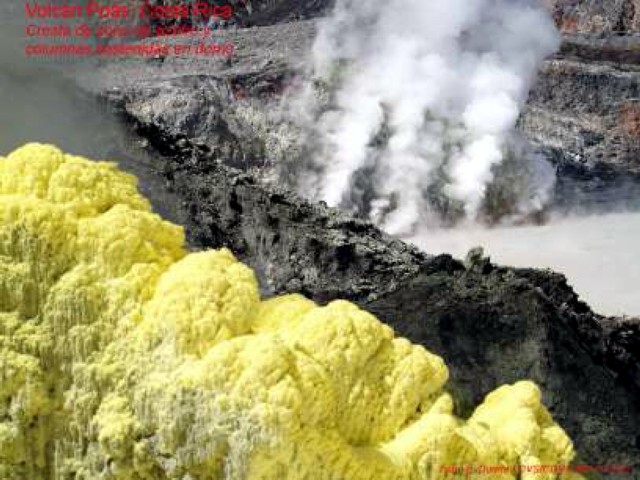Report on Poas (Costa Rica) — September 2007
Bulletin of the Global Volcanism Network, vol. 32, no. 9 (September 2007)
Managing Editor: Richard Wunderman.
Poas (Costa Rica) Many fumaroles active; small phreatic emission from crater lake in December 2006
Please cite this report as:
Global Volcanism Program, 2007. Report on Poas (Costa Rica) (Wunderman, R., ed.). Bulletin of the Global Volcanism Network, 32:9. Smithsonian Institution. https://doi.org/10.5479/si.GVP.BGVN200709-345040
Poas
Costa Rica
10.2°N, 84.233°W; summit elev. 2697 m
All times are local (unless otherwise noted)
The last Bulletin report on Poás provided information on the phreatic eruption on 25-26 September 2006 (BGVN 32:07). This report discusses continuing hydrothermal variations and one minor phreatic eruption (to 30 m above the crater lake) during October 2006 through September 2007. The pyroclastic cone continued fumarolic activity issuing columns of gases that reached 300 to 400 m above the crater. Information for this report were provided by the Observatorio Vulcanologico y Sismologico de Costa Rica-Universidad Nacional (OVSICORI-UNA).
Crater lake. During the period October 2006 through September 2007, Laguna Caliente the active crater lake of Poás volcano, displayed a greenish-gray color with convection cells in the center and temperatures ranging from 41 to 58 °C. As depicted in table 12, between 5 and 12 October 2006, the temperature and level of the lake increased suddenly suggesting a greater heat flow into the lake. By late October, the temperature decreased slightly and the level of the lake began to fall. Overall, the lake level fell 6.45 m from September 2006 through August 2007, and then stabilized. Often gases originating from the bottom of the lake produced a ring of dark gray material 80 m in diameter floating at the center of the lake. In the NE wall at the lake level, fumaroles produced yellowish particles that floated on the lake.
Table 12. For Poás, the temperature of Laguna Caliente and changes in lake level from September 2006 through September 2007. Courtesy OVSICORI-UNA.
| Date | Lake temperature | Relative elevation change in lake surface |
| Sep 2006 | 41°C | -- |
| 05 Oct 2006 | 46°C | -- |
| 12 Oct 2006 | 55°C | + 0.43 m |
| 27 Oct 2006 | 53°C | - 0.46 m |
| Nov 2006 | 48°C | - 0.33 m |
| Dec 2006 | 48°C | -- |
| Jan 2007 | -- | -- |
| Feb 2007 | 48°C | - 0.70 m |
| Mar 2007 | 49°C | - 1.11 m |
| Apr 2007 | 51°C | - 1.18 m |
| May 2007 | 27°C | - 1.45 m |
| Jun 2007 | 58°C | - 1.58 m |
| Jul 2007 | 57°C | - 0.15 m |
| Aug 2007 | 58°C | - 0.59 m |
| Sep 2007 | 56°C | + 0.08 m |
Small phreatic eruption. According to reports of a park ranger, a phreatic eruption occurred at 1230 on 16 December 2006. The eruption reached a height of 30 m and the erupted material fell back into the lake.
Fumaroles. In October 2006 the fumaroles of the N terrace emitted columns of gases and deposits of sulfur forming a small dome. One fumarole produced a whistling noise and had temperature of 144°C. By February 2007, the fumarole cooled to 124°C but continued building a small sulfur cone (figure 82). Sulfur depositions continued through September 2007 when the fumarole closed. Table 13 depicts fumarole temperatures through September 2007.
Table 13. Temperature of N terrace fumarole at Poás depositing sulfur during October 2006 through September 2007. Courtesy OVSICORI-UNA.
| Date | Temperature |
| Oct 2006 | 144°C |
| Nov 2006 | 143°C |
| Dec 2006 | -- |
| Jan 2007 | -- |
| Feb 2007 | 124°C |
| Mar 2007 | 118°C |
| Apr 2007 | 116°C |
| May 2007 | 110°C |
| Jun 2007 | 117°C |
| Jul 2007 | 108°C |
| Aug 2007 | 108°C |
| Sep 2007 | 67°C |
On the SE and NW walls, hot springs with gas temperatures between 89°C and 94°C also deposited sulfur. By March 2007, the hot springs had largely dried and only two gave off very low volume emissions with a temperature of ~55°C. Throughout the reporting period, cracks on the intermediate terrace and on the NE edge of the crater widened with new points of gases appearing and deposition of sulfurous material. By February 2007, emission levels began to diminish, and they continued diminishing through September. Fumarole gas temperatures in this area remained steady at near 94° C.
Geological Summary. The broad vegetated edifice of Poás, one of the most active volcanoes of Costa Rica, contains three craters along a N-S line. The frequently visited multi-hued summit crater lakes of the basaltic-to-dacitic volcano are easily accessible by vehicle from the nearby capital city of San José. A N-S-trending fissure cutting the complex stratovolcano extends to the lower N flank, where it has produced the Congo stratovolcano and several lake-filled maars. The southernmost of the two summit crater lakes, Botos, last erupted about 7,500 years ago. The more prominent geothermally heated northern lake, Laguna Caliente, is one of the world's most acidic natural lakes, with a pH of near zero. It has been the site of frequent phreatic and phreatomagmatic eruptions since an eruption was reported in 1828. Eruptions often include geyser-like ejections of crater-lake water.
Information Contacts: E. Fernández, E. Duarte, W. Sáenz, V. Barboza, M. Martinez, E. Malavassi, and R. Sáenz, Observatorio Vulcanologico Sismologica de Costa Rica-Universidad Nacional (OVSICORI-UNA), Apartado 86-3000, Heredia, Costa Rica (URL: http://www.ovsicori.una.ac.cr/).


